Description
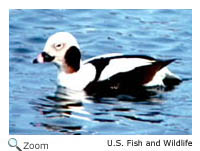 The long-tailed duck is a medium-sized diving sea duck. It is 15-22 inches in length with a wingspan of
around 30 inches. It has a round head; a stubby bill; short, black, pointed wings; and a stocky body. The male has a black and white face and a long, black central tail feathers during breeding season. The female is a mottled brownish-gray and doesn't have the long tail feathers. The long-tailed duck is a medium-sized diving sea duck. It is 15-22 inches in length with a wingspan of
around 30 inches. It has a round head; a stubby bill; short, black, pointed wings; and a stocky body. The male has a black and white face and a long, black central tail feathers during breeding season. The female is a mottled brownish-gray and doesn't have the long tail feathers.
Range 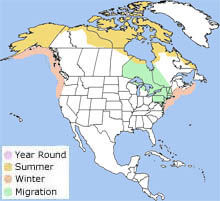 The long-tailed duck breeds in Alaska and northern Canada. It winters along the Pacific Coast from Alaska south to California and along the Atlantic Coast from Canada south to North Carolina. It may also winter along the Gulf Coast and the Great Lakes. The long-tailed duck breeds in Alaska and northern Canada. It winters along the Pacific Coast from Alaska south to California and along the Atlantic Coast from Canada south to North Carolina. It may also winter along the Gulf Coast and the Great Lakes.
Habitat
 The long-tailed duck breeds on ponds, streams, and wetlands in the tundra. It winters on ocean shores and inland lakes. It is sometimes found away from shore on the open ocean. The long-tailed duck breeds on ponds, streams, and wetlands in the tundra. It winters on ocean shores and inland lakes. It is sometimes found away from shore on the open ocean.
|
|
Diet 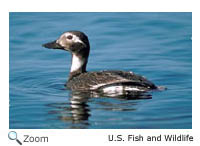 The long-tailed duck dives from the surface of the water for mollusks and crustaceans. During breeding season, it may also eat fish, plants, insects, and insect larvae. The long-tailed duck dives from the surface of the water for mollusks and crustaceans. During breeding season, it may also eat fish, plants, insects, and insect larvae.
Life Cycle
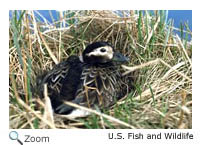 Male and female pairs form before or during migration. The female lays 6-11 eggs
in a depression in the ground that is close to water and well hidden by vegetation. The male leaves the female once incubation begins. The eggs hatch in 25-30 days. The chicks are precocial and feed themselves shortly after hatching. The chicks fledge when they are a little over a month old. Male and female pairs form before or during migration. The female lays 6-11 eggs
in a depression in the ground that is close to water and well hidden by vegetation. The male leaves the female once incubation begins. The eggs hatch in 25-30 days. The chicks are precocial and feed themselves shortly after hatching. The chicks fledge when they are a little over a month old.
Behavior
The long-tailed duck uses its wings to propel itself under the water and can dive to depths of up to 200 feet! The long-tailed duck was once called the oldsquaw.
|

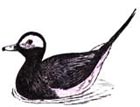

 The long-tailed duck breeds in Alaska and northern Canada. It winters along the Pacific Coast from Alaska south to California and along the Atlantic Coast from Canada south to North Carolina. It may also winter along the Gulf Coast and the Great Lakes.
The long-tailed duck breeds in Alaska and northern Canada. It winters along the Pacific Coast from Alaska south to California and along the Atlantic Coast from Canada south to North Carolina. It may also winter along the Gulf Coast and the Great Lakes.


